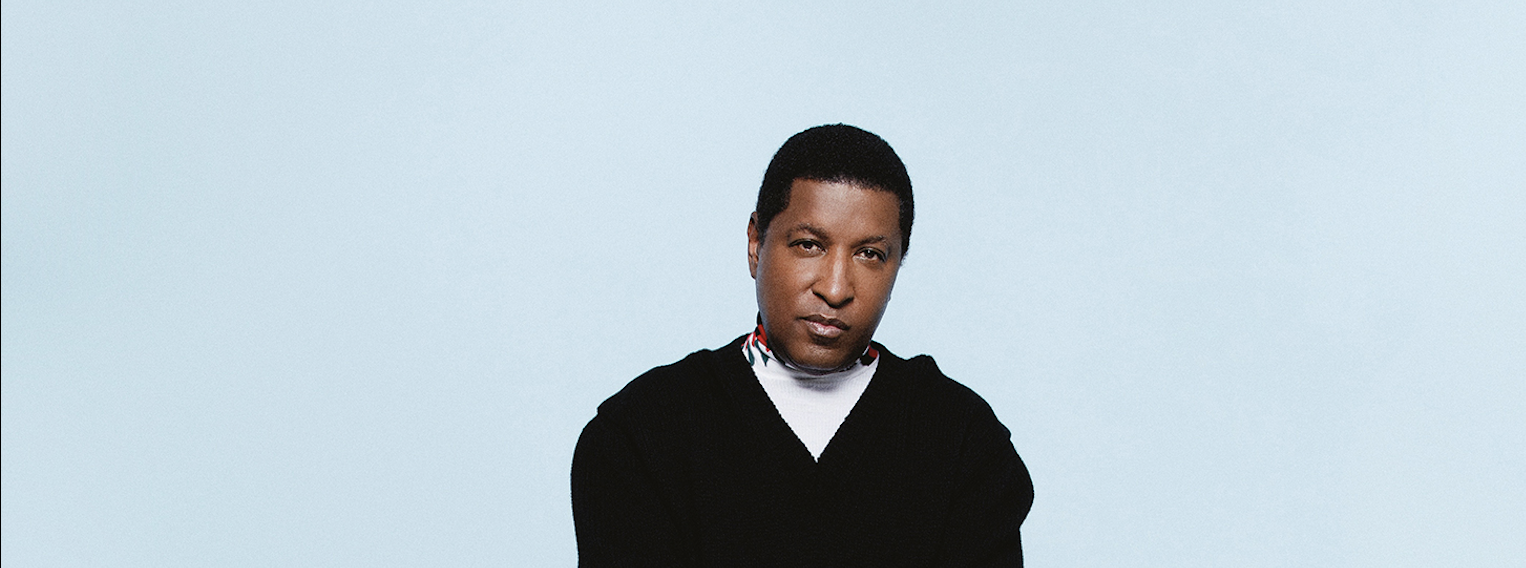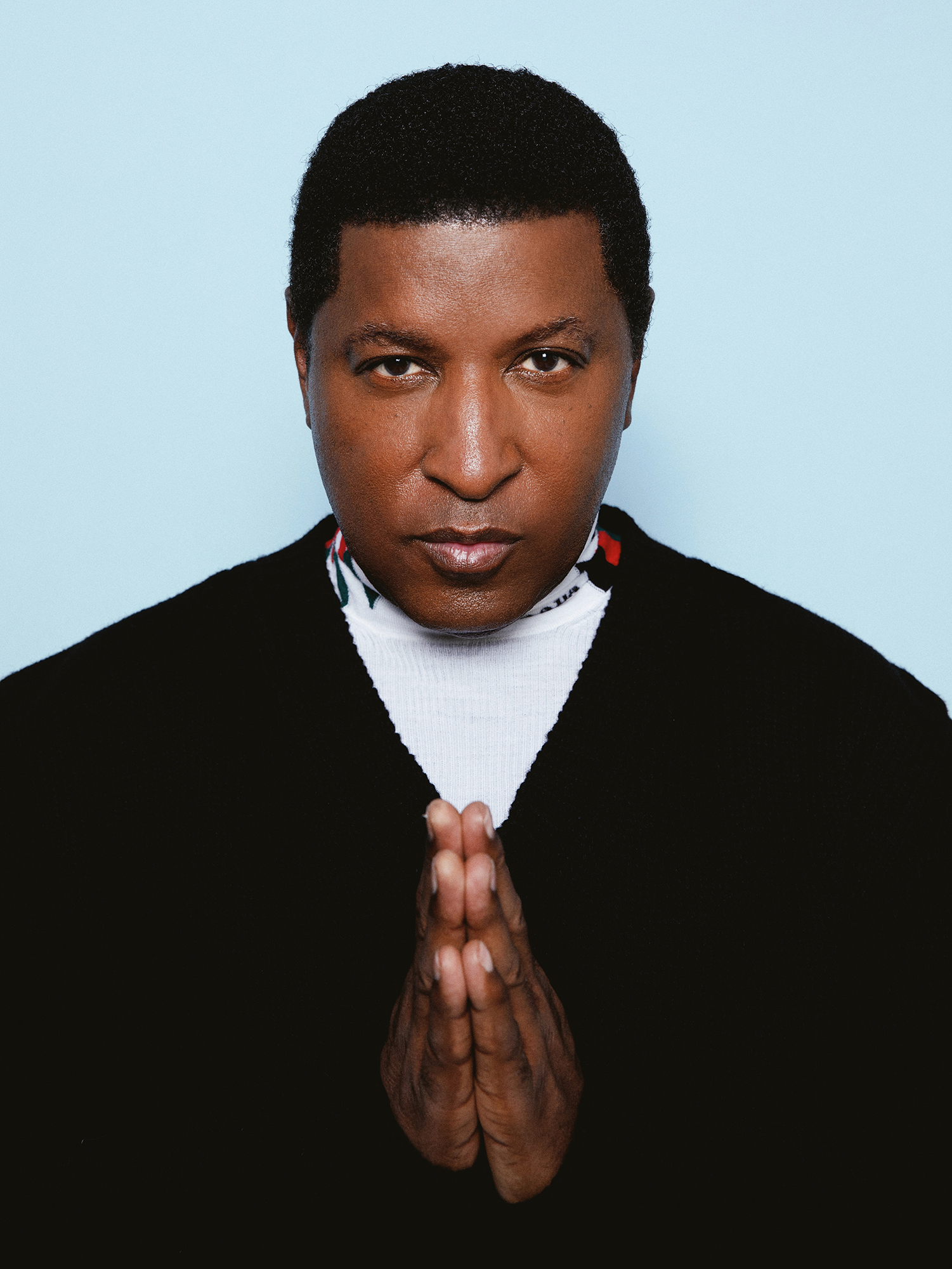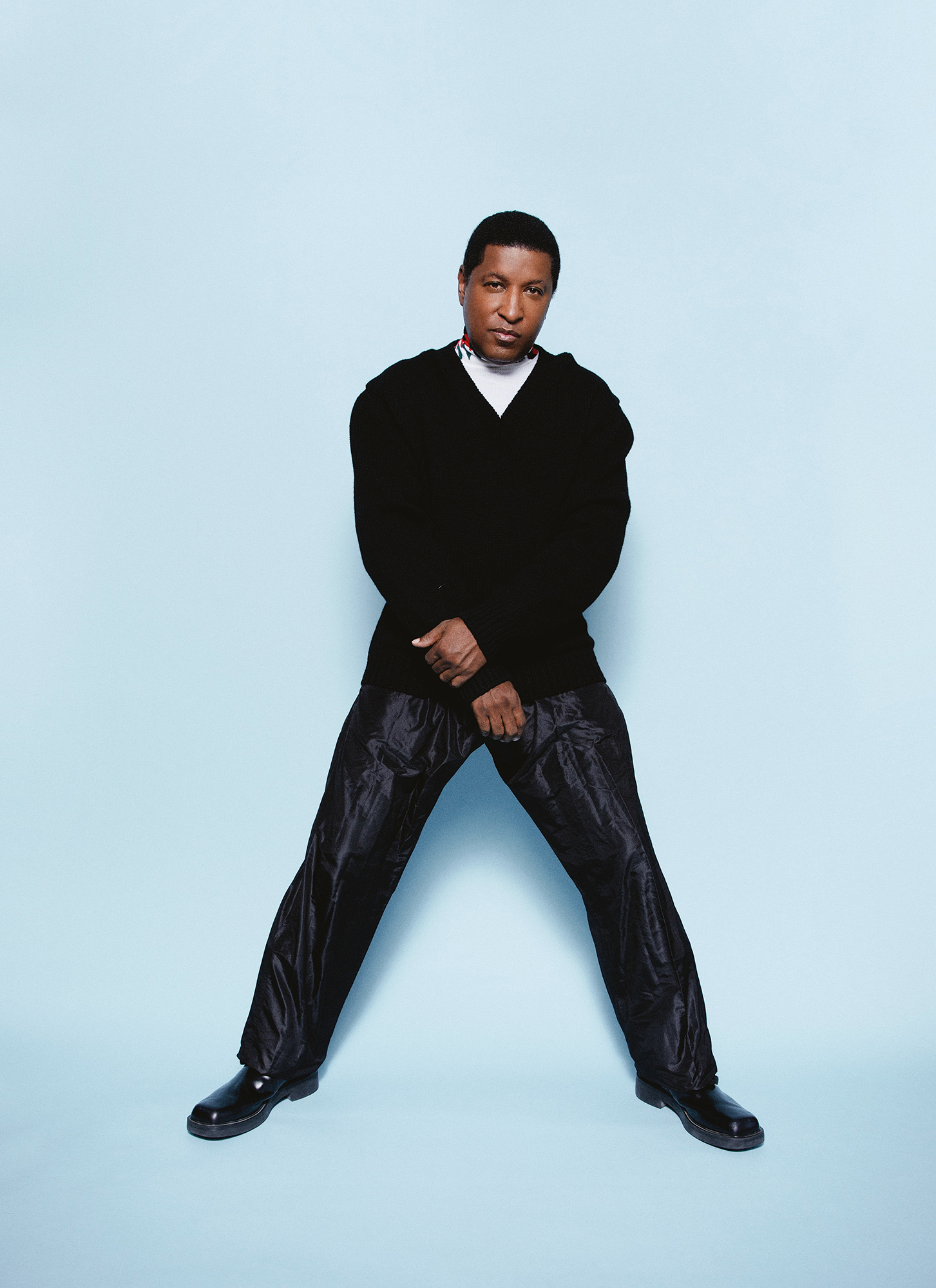Heroes: Babyface
After six years away from the studio, the music industry icon returns with a new album featuring R&B’s latest and greatest songstresses

This feature appears in V139, Supermodel, Superhero issue, now available for purchase.
In the music world, one-name recognition is reserved for industry legends only. Sought by many and held by few, “legendary” status is enigmatic. The subjective term brews debate between music junkies alike. At its core, it’s purely philosophical: how do we determine the best of the best? Is it the number of records sold? Countless radio hits? A chart-topping versatility between genres?
No matter how you calculate it, Babyface defines it. His eye-watering list of accolades crowns him as nothing less than a musical pioneer. With over 800 million records sold, 125 Top 10 hits, 12 Grammy Award wins and a star on the Hollywood Walk of Fame to boot, Babyface is widely hailed as one of the greatest forces in music history. The mononymous superstar is renowned for his godlike ability to bestow household name status onto up-and-coming talent. Madonna, Whitney, Usher, Mariah, Beyoncé—his list of featured collaborations reads like a Billboard Hot 100 lineup.

Babyface’s sonic recognition transcends from Gen X to Gen Z. From R&B to pop music, the singer, songwriter, and record producer has woven his illustrious discography into the social fabric of generations—soundtracking first encounters, weddings, heartbreaks, and award-winning feature films.
But before there was Babyface, there was Kenny Edmonds. His climb to icon prestige kicked off far from the glitzy Los Angeles valley he would go on to call home—over 2,000 miles away in 1960’s Indianapolis. Born to humble roots, Edmonds was raised by his widowed mother after tragedy struck the family when he was in the 8th grade. Shy and naturally soft-spoken, it was through music that Edmonds curated his uncanny ability to express the emotions he could feel but didn’t have the words to say. Thus, an unparalleled Midas touch was born.
Blasting onto the world stage in 1989, Babyface first entered the top of the charts with his synth-fueled upbeat single “It’s No Crime.” Paired with honey-sweet vocals and a shapeshifting comfortability both in front of the mic and behind the mixer, the multi-hyphenate talent began turning the heads of every industry bigwig. His genre-diffusing prowess and a burgeoning hit-making reputation were the perfect storm for the creation of LaFace Records. A defining force of the nineties and noughties, Babyface’s label would shape the next generation of R&B music.
Now, over three decades since the release of his first record, Babyface unveils his latest pièce de résistance in the form of his high-octane, ninth studio album, Girls Night Out. Star-powered collaborations champion the 13-song tracklist including contemporary icons, Kehlani, Ella Mai, Baby Tate, and more. In a true testament to an evolving R&B genre, Babyface maintains his quintessential soul-baring lyricism and modernizes with the most contemporary beats as only the best of the best can do. Perhaps that’s how you define “legend”.
Read the exclusive interview with the R&B Pioneer below where he details the conceptualization of his latest masterpiece, discovering how his music is still influencing the youth decades later, and how he’s approaching the evolving landscape of R&B.
V MAGAZINE: First off, obviously I have to congratulate you on the new project. It features a really strong roster of talent, which I think is quite exciting. But before we get into the talent that you tapped for this, I just want to hear a bit about the inspiration for it. You’ve been involved in R&B and I feel like you’re almost synonymous with the genre. When you think of R&B you think of Babyface. What about this particular moment in time made you want to explore a rising generation of R&B, specifically the new leading ladies of the genre?
BABYFACE: Well, I think what initially led me there was when I did Verzuz in 2020 I ended up finding out that I had a much younger audience that was actually kind of interested in music that I was doing. And I wasn’t aware of that. So I was thinking of, you know, in terms of doing more music, I wanted to still be able to do music that would connect and, and not necessarily just repeat the ‘90s again. So I wasn’t exactly sure what to do, but my partner on this record that helped produce it, actually came up with the idea that I should work with the new [age] R&B girls. And similar to how I did the Waiting to Exhale soundtrack. But this time, the idea was to actually do it with them, and collaborate. On that album, I produced and wrote everything, but on this album, we produced and we wrote everything collectively. And so that way, it had both of our voices, and I could help guide it and kind of bring a sense of my experience to the table and also be able to try to help their voices as well. And it worked out well in that way.
V: Can you take us through a bit of the process of putting this entire thing together? How long did it take you? Because it’s twelve features from twelve different ladies?
B: It actually took a while just with schedules, and just openly going through the process of finding artists and ones to work. Then the actual time of recording, almost every recording, the majority of them, were recorded and written in the same day. So we didn’t have any real time to write anything in the process. The artist would come into the studio, we’d sit and we talk about what’s going on in their life, and what do they want to write about? And we used their life as a baseline, you know, are they happy? Are they sad? Are they in love? Not in love? And then from there let’s figure out what to write.
So I didn’t [fully] realize exactly what we were doing at the time. I think that with each artist, I was always approaching it like we didn’t have any other time but that time. So it ended up being kind of a quick write, quick record. And then I’d take what we would do and then build up on that and produce the rest of it. But other than that, it was kind of just about being present in that moment, which worked out really well. The girls were all great and the process of finding the girls was pretty smooth. I knew Kehlani and Ella Mai, I was a big fan and Ari Lennox but a lot of the other girls I wasn’t completely aware of. My partner was sending me either a YouTube video of them or Spotify and I listened to their voices and saw whether they were someone that I could work with. That’s kind of how it happened, so, a lot of surprises came. Like I wasn’t aware of Tiana Major9 before this. Same thing with Coco Jones, I didn’t know if she was an actual singer, I thought she was just an actress but she’s clearly a singer as well. And then of course we have Muni Long and a number of artists that came in like Queen Naija.
It was a great process of just being able to work with girls that had voices and and also had a point of view. Their own point of view with what they want to say and how they wanted to say it. My [responsibility] when it came to the recording was to push them a little more than maybe they have been used to in terms of just vocal production and everything just to get the best out of them.
V: You briefly mentioned the other ladies and what they brought to the table and how familiar you were with them, but can you talk a bit about Doechii in particular? We know her to be an experimental rapper, but what made you want to add that element of surprise of including someone who is a force in HipHop as opposed to R&B?
B: Doechii was an artist that my partner was looking at. She kept telling me about her. She said, “This girl’s hot. No, she’s a rapper. But she kind of rap-sings as well. And you really just need to check her out.” So I listened to her and she was great, her sound was refreshing. I wasn’t exactly sure what we were going to come up with when she came in. She was amazing, she’s got so many skills, she can also write. Just her sort of energy in general was almost [magical], she’s just a star. I’ve worked with a lot of stars in my past. But when she came in, I just thought, “Okay, this is one that is one to watch.” And what she came and brought to the table was amazing. You know, she ultimately came with the title song, it wasn’t anything that I said, “Let’s do,” it just kind of happened organically. So it was a great experience.
V: The amazing female artist of course gained so much from working with you, as you’re a legend. You have this skillful eye and ear when it comes to music but I’m curious to hear what you gained from the experience of working with them? Was there any new ways of creating/producing music or writing that you kind of learned from them?
B: No question. It was a learning experience for me, in terms of being able to be with them, hearing how they felt in their phrasings melodically and their phrasing in terms of lyrics, what they say, how they say it, it’s all about communicating and communicating to an audience that speaks a particular way or hears things a particular way. So, if I was writing songs in a very ‘90s way, the lyrics would be different and the words would be different, some things wouldn’t hit the same. So it definitely was a learning process throughout.
When I was with them, I would say to them, “does this sound too ‘90s? Does this sound too whatever? Let me know. Because we can switch gears.” Because I had already picked up a lot and fortunately, they weren’t shutting down a lot of my ideas that came, but I was open to that. I was open to let them guide it as well. I was making sure they knew that it was a collaboration and I wasn’t trying to just control it all. So no question about it, I learned a lot in the process of writing melodies, and in rhythm, the whole thing, the flow. It was definitely like taking a class of today’s R&B and learning how do I work within that system, how do I bring more to the table.

V: It’s so interesting, you mentioned briefly how when you were working with them that you would check in with them to see if something sounded or was too ‘90s for them? I kind of feel like the album itself is the perfect blend of still having that classic Babyface sound, like the ‘90s Classic R&B, but then there’s a touch of modernity to it as well. How did you go about curating that?
B: I think it’s just what came naturally from the blending of the two and being careful not to go too far either way, if possible. So it was a line that we had to walk either way. And I think that most of the girls were pleasantly surprised that I didn’t take it too far either way, and I think they walked out feeling like they got something out of it as well.
V: Building off of this project to basically look at the scope of your work over the past 30 years, how would you say that this project is different for you? Did it feel different creating this than previous projects? Did this feel a little bit more special? I know most artists don’t like to compare their babies, they look at all of their projects as their babies, but I would love your take on this!
B: Well, I can say this experience was a lot different, in that this was more of a collaborative effort than maybe what I’ve done before with so many different people. This project [encapsulates] so many different flavors, that if I did do it with one artist, then you’d kind of keep going down the same road…and end up with the same flavor. But doing this, with each one of the ladies [featured on the project] meant that the door was open to go wherever we wanted creatively. That was the fun in the process. What’s unique about the album is that it isn’t just one artist. It isn’t just about one theme, or one idea. It’s about whatever the ladies came up with in the moment. So, it’s really theirs. I did very little on it. I showcase myself very little on it, because it really wasn’t about me, it was really about showcasing them.
V: The album is out currently right now, so you’ve kind of been able to get a read on the reception for it. Can you tell me what that reception has been like at least through your eyes? And what do you want the listeners to take away from the album?
B: Through my eyes, it looks like it’s doing exactly what it’s supposed to do. There’s something for everyone. There are some things that aren’t for everyone. But for the most part, it’s been a great reception to it. We’ve worked really hard on trying to put it out there and let everybody know that it’s here. There are new artists on the project for people to discover, and that right there is a great thing and it feels amazing…more importantly it means I did my job. It’s the kind of project where I think everyone can sit and marinate for a while. And that’s what I’m hoping for.
V: Building off of what you just said of this project sitting and marinating for a while, what would you say is the future of R&B? What does that look like or sound like to you?
B: I think the future of R&B is in good hands, I think that R&B still influences so many other genres as well. R&B is no longer defined by whether it’s a love song, or whether it’s speaking of love, or saying things in a particular way. It’s R&B, it’s rhythm and blues. It’s something that comes from so long ago, back to Motown days back, even before. So it is something that has always influenced and will keep influencing. I don’t think that one could ever say that R&B is dead. Some people may say that love songs are dead right now in terms of how we used to make and sing “I’ll make love to you” and those kinds of things. Yeah, that’s not what everybody’s kind of talking about on social media. It’s not what the flavor is at the moment. But that flavor may change. Music always reflects what’s going on in the streets and what’s going on in people’s hearts. And so I think it is appropriate for what we hear. I think it’ll change as people change, which is the beauty of music.
Girls Night Out is now available on all streaming platforms.
This feature appears in V139, Supermodel, Superhero issue, now available for purchase.
Discover More
